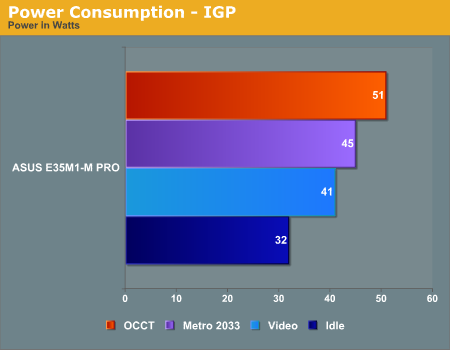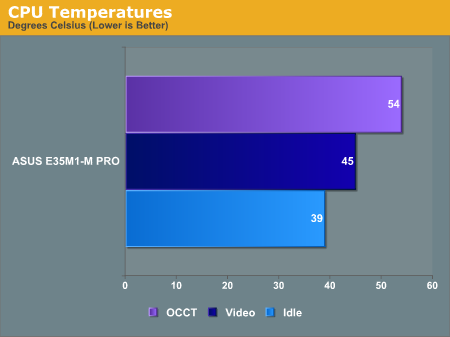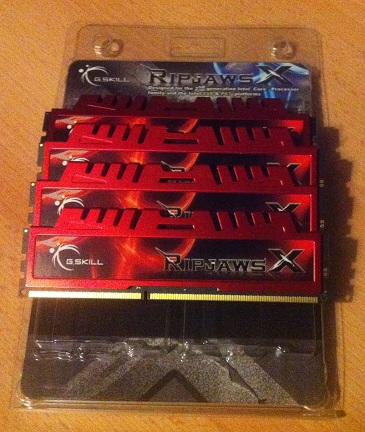ASUS E35M1-M Pro Review - Anyone For Fusion?
by Brendan van Varik on October 25, 2011 5:00 AM EST- Posted in
- Asus
- Motherboards
- Fusion
- E-350
Test Setup
| Processor |
AMD Fusion APU E-350 Dual-Core 1.6 GHz Up to 2 "Bobcat" cores, FT1 BGA 80 Stream Processors, 500 MHz |
| Motherboards | ASUS E35M1-M PRO |
| Cooling | Standard Cooling |
| Power Supply | Jeantech 250 W |
| Memory | G.Skill RipjawsX F3-14900CL9Q-16GBXL |
| Memory Settings | DDR3 1333MHz - 9-9-9-24 1T at 1.5 V |
| Hard Drive | OCZ Vertex 3 240GB |
| Optical Drive | Samsung SH-S223Q |
| Case | Dimastech Bench Table |
| Operating System | Windows 7 64-bit Ultimate |
| SATA Testing | OCZ Vertex 3 240GB |
| USB 2/3 Testing | Patriot 64GB SuperSonic USB 3.0 |
Many thanks to…
Before we go any further, I'd like to take the time to thank G.Skill for providing us with a set of their RipJawsX RAM for my future AMD reviews, in particular, the F3-14900CL9Q-16GBXL kit of which two sticks were used. It is a 16GB (4x4GB) kit which is rated at DDR3-1866MHz with 9-10-9-28 timings on as little as 1.5 volts. It is currently available from Newegg for $149.99.
Power Consumption
Power consumption was tested on the system as a whole with a wall meter connected to the power supply, while in an IGP configuration. This method allows us to compare the power management of the UEFI and the board to supply components with power under load, and includes typical PSU losses due to efficiency. These are the real world values that consumers may expect from a typical system (minus the monitor) using this motherboard. The power supply used for this test was a generic 250W model from JeanTech.

Out of the A50M motherboards which we have had on test, the ASUS E35M1-M PRO has the lowest average power rating across the four tests which we ran.
CPU Temperatures
With most users running boards on purely default BIOS settings, we are running at default settings for the CPU temperature tests. The results of a CPU Temperature test are not easily interpretable – if a motherboard vendor has buffered the amount of copper in the board between the power delivery and the CPU, this lowers the resistance and increases the CPU default voltage causing higher temperatures (but better stability). However, a high temperature could result from using different types of onboard devices, FETs, or the quality of the CPU temperature sensor, so the overall interpretation is purely speculative. The only thing a CPU test can say for sure is how warm the CPU is.
It could be argued that the CPU temperature is an indication of how well (or how adventurous) the vendor has their BIOS configured on automatic settings. A certain number of vendors not making CPU voltage, turbo voltage or LLC options configurable to the end user, which would directly affect power consumption and CPU temperatures at various usage levels.

The thermal tests were conducted without the included fan, just like the other Fusion motherboards. As you would expect, the temperatures are significantly lower if you use the fan. For example, if you stress the system with OCCT, the temperatures come down from 54 °C to just 39 °C. The fan is whisper quiet during normal operation and should not be noticed in a HTPC environment - however, when the system is stressed and the fan speeds up to 100%, it does get quite loud.











66 Comments
View All Comments
hackztor - Tuesday, October 25, 2011 - link
I have the non pro version and after 2 months the nic died. I sent it in to asus repair and they said they repaired it and its still dead. Going to return it to newegg. The problem when the nic dies is their is only 1 slot on the non pro and that is used by my sata card stuff.ven - Wednesday, October 26, 2011 - link
Nobody is going to use a discrete graphics card with this board i don't know why all the manufactures uses x16PCIe slot.I was greatly surprised to see the presence of the slot for the first time before i came to known it was working in x4 mode.And also i don't think apart from video card there is no other PCIe card which extends that much length.mino - Wednesday, October 26, 2011 - link
Because it is really PCIe x4 slot and why not give you a full PCIe x16 instead of limiting user choices needlessly ? ...Mugur - Wednesday, October 26, 2011 - link
Nice review, but I was waiting for an E-450 review... :-) At least in Europe, there is an Asus model widely available.silverblue - Wednesday, October 26, 2011 - link
http://laptoping.com/amd-e-450-amd-radeon-hd-6320-...Death666Angel - Wednesday, October 26, 2011 - link
In one instance you talk about being "well within statistical variance", in another, you make it sound as though a .31 fps difference (which amounts to 1% deviation in this case) is grounds to separate the devices used.
Either you go all the way (and are wrong) and don't mention statistical variance and treat every result you have as being 100% perfect. Or you do take into account standard deviation and variance and don't make a 1% difference into an actual difference.
Otherwise, a good board and a good review. :-)
Though I still think a small Llano or a small Corei3 maintain the better package and don't really cost that much more. Cooling can be handled silently as well.
Daedalus454 - Wednesday, October 26, 2011 - link
I just upgraded my home server to this board last night. I'm running two Debian VMs on Xen. The E-350 is the fastest low-power system that I'm aware of which supports virtualization - AMD-V in this case. Atom based boards do not support VT-x. The extra slots on this particular board are nice as I need the PCIe x4 slot for my RAID controller, and this board gives me an extra x1 slot to add a second NIC if I need to do so in the future.The old system was a Brisbane Athlon 64 x2, I don't recall the speed. With the E-350 board performance is quite good. My VMs are running well and SMB transfers are quick.
The reason for my switch was that the old system pulled about 95 watts idle and 135 watts normal load and generated a lot of heat. That got uncomfortable since the server lives in my bedroom closet. The new system draws 65 watts full bore. Both systems include a Dell PERC5/i RAID controller and 3 1.5TB hard drives in RAID5. Xen doesn't seem to be very good about switching power states on this board however. I might need to adjust some settings on my Dom 0.
EVRE - Wednesday, October 26, 2011 - link
My friend who lives off the grid just build one of these.His setup:
Crucial 120gb m4 ssd
8gb of standard 1333 ram
sata dvd rw
DC DC 80w power supply from 12v corded brick (looks like an xbox 360's)
His idle power consumption is 16-17 watts at the wall with a Kill A Watt.
fluxtatic - Thursday, October 27, 2011 - link
For those who say go cheap on a SB system, consider that then you end up with some crap Biostar board. Here, you're getting an Asus (it seems to swing either direction, but they are one of the largest for a reason.) If you could build a comparable SB system on a decent board (Asus, Gigabyte, MSI), then maybe we're have a real debate. YMMV, but I would never recommend a cheap knockoff MB to save a few bucks on system like this.As to the x16 slot, I have come to the conclusion that it's a cost thing - a company like Asus is going to be buying the x16 slot connectors by the truckload, making the cost nothing. They're not going to get nearly as good a deal on open-ended x4-sized connectors, given that they would likely only be used on these Fusion boards (how often do you see dedicated x4 slots?)
I picked up a Sapphire Pure board in the spring, building a NAS/HTPC/server sort of thing...had I known that it wouldn't be done by now (waiting on the final finish for the scratch-built case), I would have waited...mine was $140, as I recall, was one of 2 that had 5 SATA ports. I almost bought this Asus, but it was a decent amount more then - $170 or so.
When it gets down to it, the Brazos platform outdoes Atom in everything but power consumption. If you look at Atom+Ion, they're closer, but Brazos still has a bit of an edge, and Ion brings the power consumption up to comparable levels, too. Face it - on this front, AMD finally has a winner. Cold comfort for those of us who waited (and waited) on BD, but there it is. Now I'm waiting for the Krishna core next year - I might just build two new boxes on that if AMD keeps up what they've done with Brazos so far.
Aries1470 - Thursday, October 27, 2011 - link
Hmm... I looked in the comments and also selected the print version too, it is shown in the picture of the back panel, it was even left out on page 3, board features.Why is that? I guess some people would still be interested in ieee-1394a.
It is also on the Asus' website:
http://www.asus.com/Motherboards/AMD_CPU_on_Board/...
one on the backpanel and one on the board too ;-)
Ok, end of rant :-)
Nice and informative article. Thank you.
Now to wait for the review of the Zotac ZBOX Mini-PC. This has the Via cpu, and is a great alternative to the Intel Atom too, and for Watt to Watt, might actually beat or be similar to this board.
Info on some of their Via Nano and Nano X2 boards here:
http://www.zotac.com/index.php?lang=un
Just search the site.
So Brendan, any idea when to expect an Atom vs Nano X2 vs AMD E or C series?